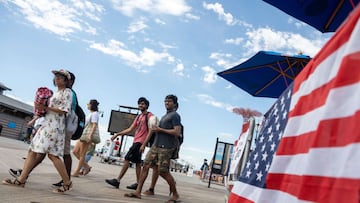Labor Day in the USA - which president made it a national holiday?
Americans will celebrate Labor Day on Monday, September 4. Although reluctant to do so, the president who introduced it thought it’d be a good vote-getter.


On Monday, Sept. 4, 2023, Americans from coast to coast will celebrate Labor Day. The workers’ holiday marks the unofficial end of summer and is supposedly the time to put away your white clothes. But how did this holiday come about and who is to thank for its establishment?
Labor Day celebrates the contribution and achievements of American workers and it is celebrated on the first Monday of September each year. The annual parades were first introduced by the labor movement in the late 19th century and Labor Day became a federal holiday in 1894.
Also see:
During the industrial revolution in the late 1800s the average American worked 12-hour days for seven days a week just to make ends meet. In many states around the country children were permitted to start working from the age of five in mills, factories and mines.
Work conditions were unsafe, with little access to fresh air, sanitary facilities and hardly any breaks. As manufacturing work started to outstrip agriculture, in the late 19th century workers started organizing strikes and rallies to protest poor working conditions, long hours and the number of days they worked.
READ ALSO: Are banks and the post office open on Labor Day?
This Labor Day weekend, millions of Americans will thank union workers and enjoy our beautiful National Parks. My favorite is San Francisco’s Presidio, a model for all who love the outdoors and a showcase of our obligation to #ActOnClimate for present and future generations! -NP pic.twitter.com/83mj8SMYc2
— Nancy Pelosi (@TeamPelosi) August 31, 2023
President Cleveland made Labor Day a federal holiday
Grover Cleveland was serving as the 24th President of the United States when he signed the celebration of Labor Day into law on 28 June, 1894. Americans had been calling for better working conditions since 1882, but it took Congress 12 years to designate it a national holiday.
He had been reluctant to officially sanction Labor Day as a national holiday for fear that it would further embolden the labor movement, which was becoming increasingly powerful in American society.
However that changed when he was forced to appease working class voters in the aftermath of the Pullman railroad strike.
The Pullman Palace Car Company manufactured railroad sleeper cars used all across the US but workers went on strike in 1894 when company owner, George Pullman, slashed workers’ wages without lowering the housing prices in his company town in Chicago.
Many of the unhappy workers protested but they were swiftly fired by Pullman, sparking a strike of the American Railway Union.
DYK... the first Labor Day celebration took place in New York City 140 years ago? Learn more about the history of why — and how — we celebrate workers on Labor Day: pic.twitter.com/A6fy2zWiNn
— U.S. Department of Labor (@USDOL) September 2, 2022
The strike was led by labor activist Eugene V. Debs, who encouraged tens of thousands of workers to walk out of factories. This was a disaster for the nation and it brought freight and passenger traffic to a halt almost overnight.
Related stories
President Cleveland sent federal troops into Chicago to enforce an injunction on the striking workers, but this only emboldened the strikers who destroyed hundreds of railroad cars in South Chicago in response. Cleveland felt that he needed to crack down on the protestors and on July 7, 1894 National Guardsmen began firing into the crowds to disperse them. It is thought that 30 people were killed, with many more seriously wounded.
Troops withdrew from Chicago on July 20 and Cleveland hailed the intervention as a success, but he had made enemies of the powerful labor unions and alienated working class voters. In order to restore some popularity with workers, Cleveland signed a bill into law on June 28, 1894 which made Labor Day a national holiday.

